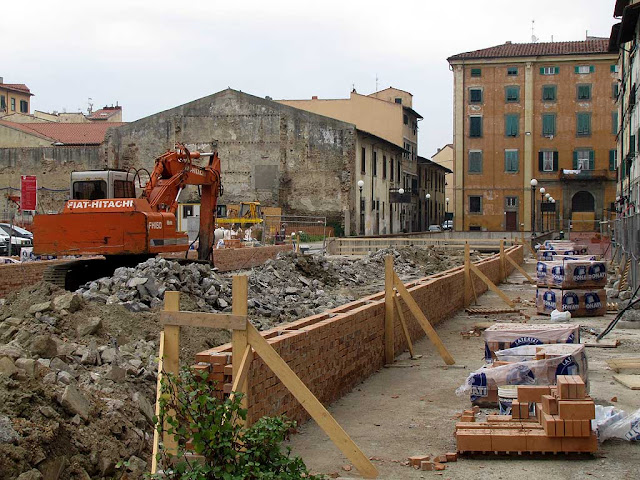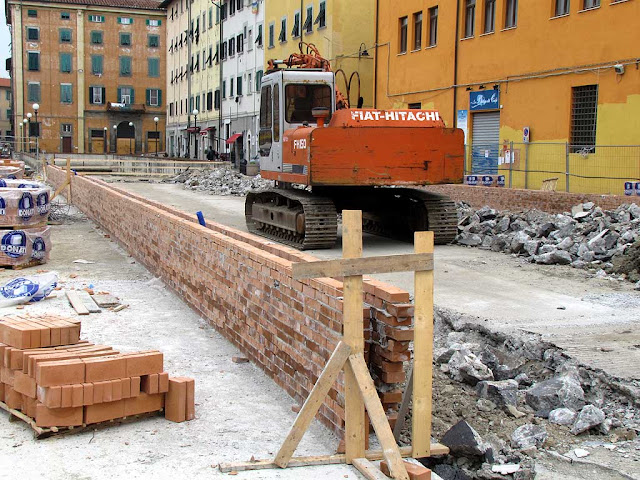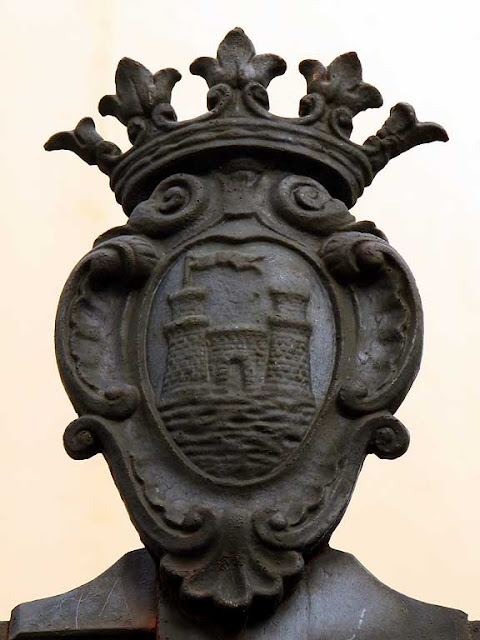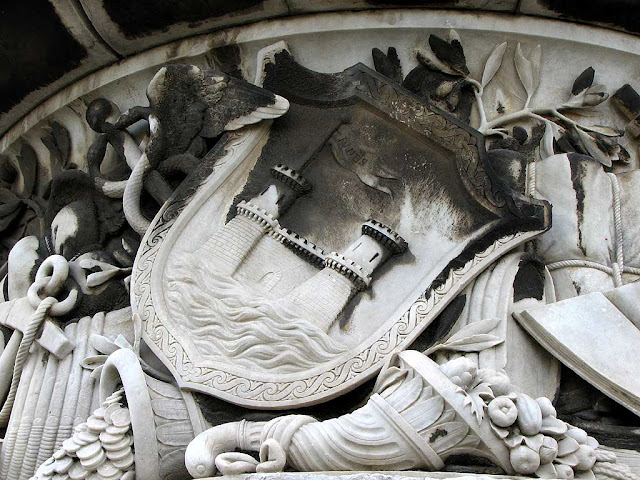Wednesday, March 31, 2010
San Sebastiano
The central “Palazzo San Sebastiano” (Saint Sebastian Palace) was designed in 1926 and built in 1929, with two nearby buildings, for the “Istituto Nazionale Immobiliare”.
On the side facing the Cathedral the building has a an interesting loggia, with a terrace above, and a high relief of Saint Sebastian on the corner with “Via San Francesco”. The poor Saint Sebastian is closely guarded by the traffic cameras of the “Zona a Traffico Limitato” (limited traffic zone).
Tuesday, March 30, 2010
Around the School
 This week my walk is more some quick trips around the “Edmondo De Amicis” school where I have to stay until Monday afternoon. On the facade of the school, like on any other building owned by the municipality, there is this funny plaque, always slightly different, probably hand made.
This week my walk is more some quick trips around the “Edmondo De Amicis” school where I have to stay until Monday afternoon. On the facade of the school, like on any other building owned by the municipality, there is this funny plaque, always slightly different, probably hand made. A weird mural nearby, to say “tanto” (much) love...
A weird mural nearby, to say “tanto” (much) love... I don't think this fence will last many more years.
I don't think this fence will last many more years. A nice pink “villetta” on the same street of the “De Amicis”.
A nice pink “villetta” on the same street of the “De Amicis”. Another “madonnina”, opposite the main entrance of the school.
Another “madonnina”, opposite the main entrance of the school. I am not sure about this, it's a small new garden, just by my mom's house, called the “Labirinto delle erbe” (Labyrinth of the Herbs).
I am not sure about this, it's a small new garden, just by my mom's house, called the “Labirinto delle erbe” (Labyrinth of the Herbs).More Walks
Monday, March 29, 2010
Inside De Amicis
 One of the first things you notice inside the “Edmondo De Amicis” elementary school is this garish in & out box.
One of the first things you notice inside the “Edmondo De Amicis” elementary school is this garish in & out box. The long hallway of the first floor receives plenty of light from the windows on the backyard while, on the right, the classrooms face a small enclosed garden and the street.
The long hallway of the first floor receives plenty of light from the windows on the backyard while, on the right, the classrooms face a small enclosed garden and the street. A sort of monument to the caretakers proudly stands on a shelf.
A sort of monument to the caretakers proudly stands on a shelf. The works of the kids are usually the most colorful thing you can see in an elementary school.
The works of the kids are usually the most colorful thing you can see in an elementary school. A problem with a school built around one hundred years ago, is that the gym has two nice columns just in the middle, to support the floor above.
A problem with a school built around one hundred years ago, is that the gym has two nice columns just in the middle, to support the floor above.Sunday, March 28, 2010
De Amicis School
 The “Edmondo De Amicis” is an elementary school built around the turn of the 19th Century in the new quarter developed around “Piazza Magenta” (now “Piazza della Vittoria”) and the church of “Santa Maria del Soccorso”.
The “Edmondo De Amicis” is an elementary school built around the turn of the 19th Century in the new quarter developed around “Piazza Magenta” (now “Piazza della Vittoria”) and the church of “Santa Maria del Soccorso”. As a kid I attended this school with my little brother, and I keep coming back here every time there is an election.
As a kid I attended this school with my little brother, and I keep coming back here every time there is an election. Now I have time to look at details I never saw then.
Now I have time to look at details I never saw then. The old school is still in excellent conditions, completely renewed and perfectly kept by the staff.
The old school is still in excellent conditions, completely renewed and perfectly kept by the staff. Maybe tomorrow I can show you something of the inside...
Maybe tomorrow I can show you something of the inside...See also: Antonio Benci School
Saturday, March 27, 2010
Friday, March 26, 2010
A New Canal
 The new canal where once was “Viale Caprera” is taking shape in the ordinate chaos of a construction site.
The new canal where once was “Viale Caprera” is taking shape in the ordinate chaos of a construction site. Wider sidewalks and parapets are already in place: you can see them following the line of the street lights from the part of the canal dug few years ago.
Wider sidewalks and parapets are already in place: you can see them following the line of the street lights from the part of the canal dug few years ago. The canal will be where the backhoe is, amid the brick parapets.
The canal will be where the backhoe is, amid the brick parapets. Soon everything in the area will be again like in this detailed 1824 map, courtesy of my friend Stefano.
Soon everything in the area will be again like in this detailed 1824 map, courtesy of my friend Stefano.Search labels: new canal
See also: An Useless Dig - Canale dei Navicelli - Viale Caprera - Micropoles - New Venice - Crash - The Dig - Building the Canal - Venice's Canal - The Old “Cantina” - Along the New Canal - Under Construction - The Bomb - The Buried Bomb - The Wall - Modulblock
Thursday, March 25, 2010
Of Cats and Gulls
 Technically a poor photo, but I like this gull flying toward the sun.
Technically a poor photo, but I like this gull flying toward the sun. For a one-legged bird he seems quite at ease and even smug.
For a one-legged bird he seems quite at ease and even smug. One year later, the King of the Harbour is still on his rocky throne.
One year later, the King of the Harbour is still on his rocky throne.Wednesday, March 24, 2010
Palazzo de Larderel
 In 1827 François Jacques de Larderel, a Frenchman living in Livorno since 1799, pioneered a way of extracting boric acid from the volcanic mud, using only natural steam in the separating process. A decade later Leopold II, Grand Duke of Tuscany and an enthusiastic supporter of Larderel's work, awarded him the title of Count of Montecerboli. The town, since 1846 renamed Larderello, became one of the first places in the world where geothermal energy was exploited to support industry.
In 1827 François Jacques de Larderel, a Frenchman living in Livorno since 1799, pioneered a way of extracting boric acid from the volcanic mud, using only natural steam in the separating process. A decade later Leopold II, Grand Duke of Tuscany and an enthusiastic supporter of Larderel's work, awarded him the title of Count of Montecerboli. The town, since 1846 renamed Larderello, became one of the first places in the world where geothermal energy was exploited to support industry. The “Palazzo de Larderel” is the most imposing and magnificent palace built in Livorno in the 19th Century.
The “Palazzo de Larderel” is the most imposing and magnificent palace built in Livorno in the 19th Century. In 1832 the first “palazzina” was built in “Via dei Condotti Nuovi”, now “Via de Larderel”, by Riccardo Calocchieri. The wings were added later to the original building by Gaetano Gherardi and a new facade, unifying the various structures, was built around 1850 by Ferdinando Magagnini.
In 1832 the first “palazzina” was built in “Via dei Condotti Nuovi”, now “Via de Larderel”, by Riccardo Calocchieri. The wings were added later to the original building by Gaetano Gherardi and a new facade, unifying the various structures, was built around 1850 by Ferdinando Magagnini. The large triangular gable dominating the facade frames the coat of arms of the De Larderel family with allegories of mechanics, agriculture and commerce.
The large triangular gable dominating the facade frames the coat of arms of the De Larderel family with allegories of mechanics, agriculture and commerce. Today the building is the seat of the local Civil Law Courts.
Today the building is the seat of the local Civil Law Courts.External links: “Steaming Forward”, Time, June 16, 2003
Labels:
architecture,
building,
Livorno
Tuesday, March 23, 2010
Spring Walk
 My first spring Sunday walk starts with my first tree blooms.
My first spring Sunday walk starts with my first tree blooms. A “Madonnina” on the corner of “Via San Carlo” and “Via Crimea”.
A “Madonnina” on the corner of “Via San Carlo” and “Via Crimea”. “The Legend of the Bread” is an impressive name for a bakery. But I still wonder what they use the sword for...
“The Legend of the Bread” is an impressive name for a bakery. But I still wonder what they use the sword for... A rusty old lamp, or a fake rusty old lamp, I'm not sure.
A rusty old lamp, or a fake rusty old lamp, I'm not sure. He was keeping watch from his window sill, behind the grate, but ready to jump...
He was keeping watch from his window sill, behind the grate, but ready to jump...More Walks
Monday, March 22, 2010
Four Noses
 Few days ago a local paper revealed one of the best known secrets of Livorno: the exact and unique point from where you can see all the noses of the “Four Moors”.
Few days ago a local paper revealed one of the best known secrets of Livorno: the exact and unique point from where you can see all the noses of the “Four Moors”. The noses in foreground are clearly visible, but it is better to add a closer view of the other two.
The noses in foreground are clearly visible, but it is better to add a closer view of the other two. The last nose is the hardest do catch, but here it is.
The last nose is the hardest do catch, but here it is.Sunday, March 21, 2010
Tito Neri
 An animated view of the entrance of the “Porto Mediceo”, with the tug “Tito Neri” approaching and a service boat leaving.
An animated view of the entrance of the “Porto Mediceo”, with the tug “Tito Neri” approaching and a service boat leaving. The “Tito Neri” is traveling backward, which is quite usual for tugs manouvering inside the harbor, because their type of propellers allow for a more precise and safe approach this way.
The “Tito Neri” is traveling backward, which is quite usual for tugs manouvering inside the harbor, because their type of propellers allow for a more precise and safe approach this way. Still going backward. The tug will travel normally only outside the port proper in case of rough sea or when actually pulling a ship.
Still going backward. The tug will travel normally only outside the port proper in case of rough sea or when actually pulling a ship. Modern tugboats are propelled by azimuth thrusters which can be rotated in any horizontal direction, making a rudder unnecessary.
Modern tugboats are propelled by azimuth thrusters which can be rotated in any horizontal direction, making a rudder unnecessary.See what happened few years ago, more or less in the place of the first photo: explosion on board the “Cape Horn” (Livorno, 2003).
Search labels: tug
Saturday, March 20, 2010
Buoys
 The “Pamiglione” is by far the oldest part of the “Porto Mediceo” (Medicean Harbour) and an endless source of inspiration for any kind of water reflection.
The “Pamiglione” is by far the oldest part of the “Porto Mediceo” (Medicean Harbour) and an endless source of inspiration for any kind of water reflection.

Friday, March 19, 2010
404th Birthday
 On March 19th 1606 the Grand Duke Ferdinando I de' Medici raised Livorno to the rank of city. The coat of arms was a fortress with two towers on a blue sea and a flag with the word “Fides”.
On March 19th 1606 the Grand Duke Ferdinando I de' Medici raised Livorno to the rank of city. The coat of arms was a fortress with two towers on a blue sea and a flag with the word “Fides”.This is the doorway of what once was the “Liceo Classico Niccolini Guerrazzi”, founded in 1861. I am not sure if the carving is of that period, but the crest is gorgeous even without the waving flag.
 The gate of the same school, this time the coat of arms is complete and probably more recent.
The gate of the same school, this time the coat of arms is complete and probably more recent. A detail of the decorations outside the “San Marco” Gate. The coat of arms, a bit dirty, is perfectly reproduced in stone.
A detail of the decorations outside the “San Marco” Gate. The coat of arms, a bit dirty, is perfectly reproduced in stone. The standard of the City of Livorno, with the most up-to-date coat of arms, showing the mural crown where once was a royal crown.
The standard of the City of Livorno, with the most up-to-date coat of arms, showing the mural crown where once was a royal crown.Happy Birthday, Livorno!
Labels:
coat of arms,
Livorno
Subscribe to:
Comments (Atom)




